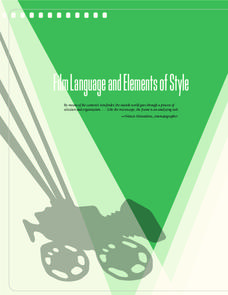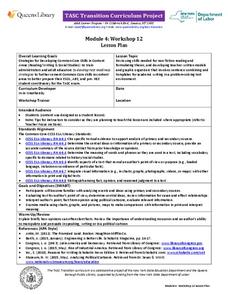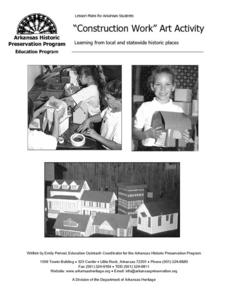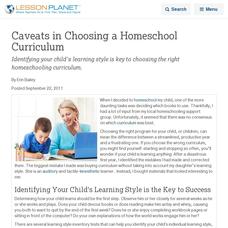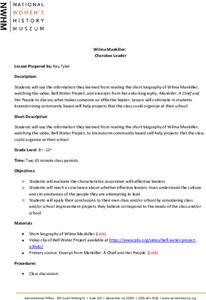Council for the Curriculum, Examinations and Assessment
Learning About Learning
Bloom's Taxonomy and Howard Gardner's Theory of Multiple Intelligences feature largely in a session that asks class members to identify their dominate learning style and intelligence. Furthermore, individuals consider how using...
US Institute of Peace
Identifying Conflict Styles
Are you a peace-keeper or a problem-solver? Explore conflict management styles through a lesson, fourth in a 15-part series, that combines individual assessment and collaborative work. Groups learn the basic tendencies of each style,...
Council for the Curriculum, Examinations and Assessment
Learning About Learning
Successful people know that they never stop learning. Eighth graders explore their preferred ways to learn new information with a reflective lesson about learning styles, that features surveys, writing prompts, and...
Council for the Curriculum, Examinations and Assessment
Learning about Learning
Encourage your sophomores to become life-long learners with the series of activities contained in this packet. Class members set goals, review personal targets, identify strategies to improve their study skills, and develop an...
US Institute of Peace
Identifying Your Conflict Style
How do you handle conflict? Individuals look inward to determine their own conflict style through group discussion and a short quiz. The sixth installment in a series of 15 conflict management lessons examines how our feelings and...
EduGAINs
Coureurs de Bois, First Nation Peoples, and the Fur Trade
The interactions between the Coureurs de bois (runners of the woods) and the First Nation Peoples as they engaged in the fur trade are the focus on this Canadian history exercise. Kids select learning centers based on their learning...
Curated OER
Arkansas Architectural Styles
Students investigate the various architectural styles of Arkansas. They read a handout, complete a worksheet, view images of architectural styles, and take photos and write descriptions of five style elements they observe in their...
Film Foundation
Film Language and Elements of Style
How do you read a frame? How do you read a shot? Here's a resource that shows viewers how to read films. As part of the study, class members examine the camera angles, lighting, movement, and cinematic point of view in Mr. Smith Goes to...
Humane Education Advocates Reaching Teachers
Justice for All - Educating Youth for Social Responsibility: Grades K-5
In grades kindergarten through fifth grade, scholars take part in a social-emotional learning unit designed to boost social responsibility. Three hundred pages provide lessons and activities related to everyday classroom practices, the...
Curated OER
Personal Learning Profile
Students investigate the life of Ghandi in order to find out how they learn. The choice of Ghandi was made because many students are not familar with him. Then student engage in different modalities of learning and take learning style...
PBS
Lessons in Leadership, Roosevelt Style
It's easy to criticize those in power until you're sitting at their desk, faced with the same decisions. A history lesson prompts secondary learners to research the Roosevelt presidencies through the lens of leadership and...
Curated OER
Storytelling: Writers' Workshop Learning Center
Evaluating a variety of narrative texts can help build strong writers. Pupils identify plot elements and their relation to personal experience, then apply what they gleaned from the class discussion to create their own narratives.
EngageNY
TASC Transition Curriculum: Workshop 12
How can opinions slant facts? Workshop participants learn how to examine primary and secondary sources and identify the author's point of view. They also examine how visual art impacts the meaning and rhetoric of sources. Full of...
Curated OER
"Construction Work" Art Activity
Students explore architectural styles and define architectural terms. They construct a building using various architectural elements, and display their buildings, identifying each of the architectural components they used.
National Endowment for the Humanities
A “New English” in Chinua Achebe’s “Things Fall Apart”: A Common Core Exemplar
To examine the “New English” Chinua Achebe uses in Things Fall Apart, readers complete a series of worksheets that ask them to examine similes, proverbs, and African folktales contained in the novel. Individuals explain the meaning...
Los Angeles Unified School District
Why Is the Declaration of Independence Important?
Fair or unfair? To begin a study of the American Revolution, class members review the treatment of the people of the American Colonies by the King of England and decide which were fair and which were unfair. Class members then annotate a...
National Endowment for the Humanities
Revolution '67, Lesson 2: What Happened in July 1967? How Do We Know?
Even in a world in which dozens of participants and curious onlookers record every controversial event, the basic facts of what happened are often in dispute. Revolution '67, Lesson 2 explores 1967 Newark, New Jersey using an examination...
Curated OER
The Rigors of Learning a New Language
Students consider the immensity of the the task the author undertook to learn Chinese. They examine the rigors involved in learning another language-particularly one as notoriously difficult as Chinese and compare aspects of Chinese...
Curated OER
Caveats in Choosing a Homeschool Curriculum
Identifying your child's learning style is key to choosing the right homeschooling curriculum.
Curated OER
Quilting Bee-Assembly Line Style
Students identify the roles of a producer and a consumer. In this economics lesson, students define the roles of a consumer and producer and produce a quilt using an assembly line.
National Woman's History Museum
Wilma Mankiller: Cherokee Leader
Middle and high schoolers consider the characteristics that make for a great leader. For example, they investigate Wilma Mankiller, the first female Principal Chief of the Cherokee Nation. Researchers read a short biography, watch a...
Curated OER
Understanding Advocacy
Students explore the work of Jane Goodall. For this advocacy lesson, students investigate the life and work of Jane Goodall. Students examine her work as an animal advocate and explore their own personal advocacy styles.
Curated OER
Jamestown
Fifth graders read literature that explains several reasons the Virginia Company was established. In this history lesson, 5th graders use different learning styles; interpersonal, artistic, logical, visual, and auditory to understand all...
Smithsonian Institution
General George Washington, Military Leader
Teach pupils the characteristics that make George Washington such an effective leader, especially in context of his time period. Scholars view artifacts, participate in group work, create lists, compare and contrast, and discuss as a...







